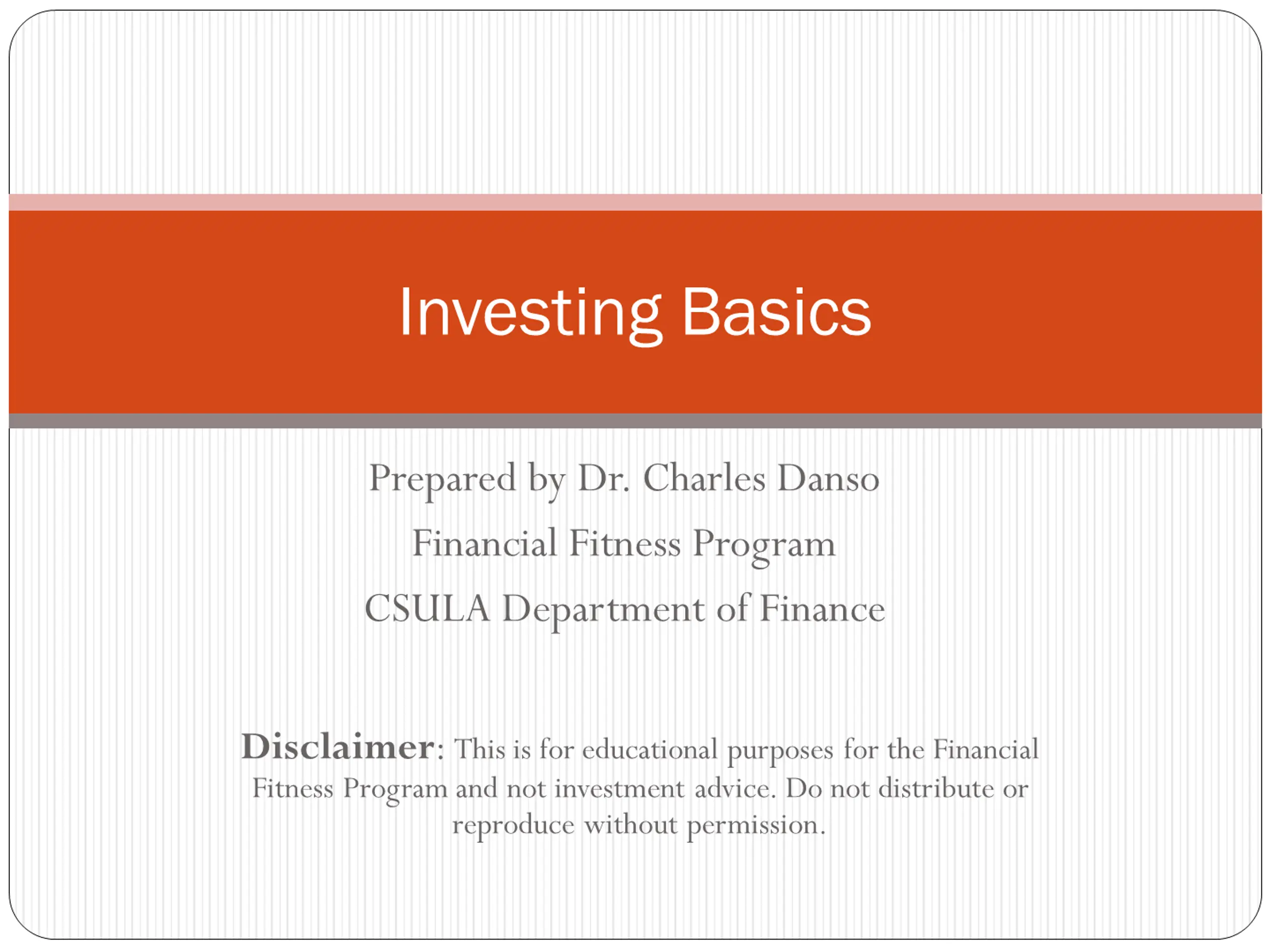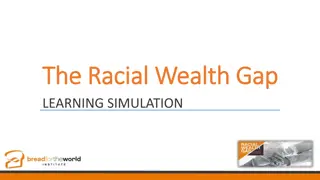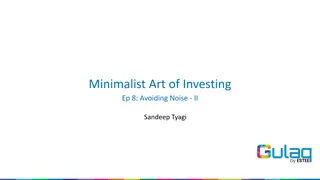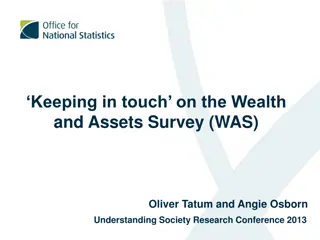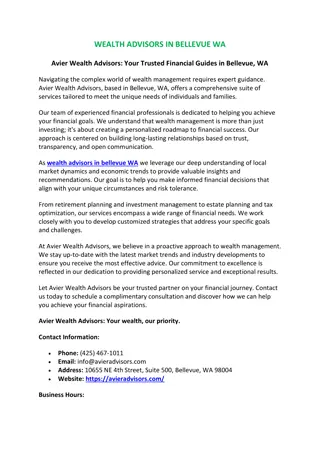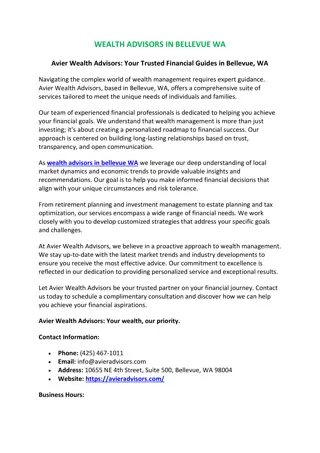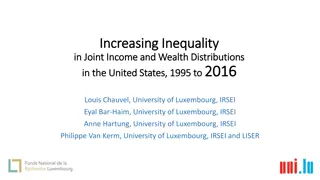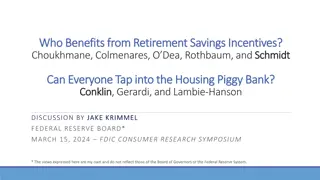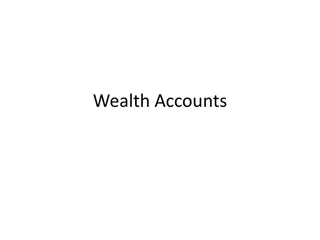Investing Basics - Maximizing Wealth through Investing
Learn the fundamentals of investing and how to allocate resources into various investment instruments to generate long-term returns and increase wealth. This educational guide covers different types of investments, investment accounts and assets, brokerage accounts, retirement accounts, stocks, bonds, and indexes. Gain knowledge on strategies and features of each investment option.
Download Presentation

Please find below an Image/Link to download the presentation.
The content on the website is provided AS IS for your information and personal use only. It may not be sold, licensed, or shared on other websites without obtaining consent from the author.If you encounter any issues during the download, it is possible that the publisher has removed the file from their server.
You are allowed to download the files provided on this website for personal or commercial use, subject to the condition that they are used lawfully. All files are the property of their respective owners.
The content on the website is provided AS IS for your information and personal use only. It may not be sold, licensed, or shared on other websites without obtaining consent from the author.
E N D
Presentation Transcript
Investing Basics Prepared by Dr. Charles Danso Financial Fitness Program CSULA Department of Finance Disclaimer: This is for educational purposes for the Financial Fitness Program and not investment advice. Do not distribute or reproduce without permission.
Investing What is investing? Allocating resources into assets or ventures with expectation of generating return or profit over time. Goal of increasing wealth over long-term Risk: There is potential to lose money & no guarantee of gains or profits. Losses can be substantial as are gains What are reasons for investing? Why do people wait to invest? What is the universal rule of investing? Buy low, sell high But how do you know when to buy or sell? Rarely does anyone know with certainty. At best people use educated guesses. 2
Types of Investment Instruments Stocks and related assets Mutual Funds Index Funds ETFs Bonds Derivatives (options, futures, etc) Real Estate Alternative Investments (art, venture capital, private equity, private lending, etc) Non-Traditional (e.g. crypto, NFTs, etc) 3
Types of Investment Account & Assets Brokerage Account (i.e. investment accounts) Stocks (Equity) Bonds Exchange Traded Funds (ETFs) Mutual Funds Currency- i.e. Foreign Exchange (Forex) or Crypto Derivatives (such as options, futures, forwards, swaps) Tax Advantaged or Deferred Accounts (i.e. Retirement Accounts) Defined Contribution 401(k) or 403(b) Individual Retirement Account (IRA)-Traditional IRA or Roth IRA 457(b) Account Employee Stock Ownership Plan (ESOPs) Defined Benefit Pensions Cash Balance Plans Alternative Investments Real Estate, Art, Jewelry, vintage, etc. 4
Characteristics of Brokerage Accounts May have trading restrictions Some instruments (e.g. forex) based on your experience Some instruments (e.g. options) based on your balance Some instruments (e.g. options) based on your income levels Based on minimum account deposit to open account May charge Fees for transactions, premium account, analyses information, & services You may be provided with a Margin Account An account where you are loaned a certain percentage to invest and you have to meet requirements to maintain that amount. 5
Features of Retirement Accounts Taxes deferred on current gains & paid when funds withdrawn Taken directly from gross pay (i.e. before taxes) Roth IRA is one exception, it is after taxes, but no interest is paid on income earned on investments Limited to investing in Mutual Funds, Indexes IRAs are one exception Incur withdrawal penalties if money taken before a certain age, usually retirement age Can use as a collateral (i.e. borrow a loan against a portion of balance) Most accounts have to be sponsored by employer IRAs are one exception You have to make a mandatory withdrawal once you reach a certain age past retirement age This is called a Required Minimum Distribution (RMD) 6
Stocks (or Equity) A financial security that grants some ownership in a corporation (usually publicly traded) Gives you right to vote on decisions Gives you right to cash flows from company Primary Market (or IPO) First time companies allow ownership by listing on a public trading exchange or selling shares to people in exchange for ownership Secondary Market: Can be traded among owners At either a higher or lower value than purchase price Investors in stocks can gain value from increase in value over time known as capital gains Investors in stocks can gain income if companies distribute returns Known as dividends Some Strategies (Based on expectations): - Buy when you expect stock to increase, - Short stock if you expect stock to decrease to gain profits 7
Bonds (or Debt instruments) Definition & Features Definition & Features An instrument that may pay you income (coupon) until it matures, then you receive some cash flow at maturity (face value, usually $1,000). Types: There are several Types: There are several Corporate Bonds E.g. High yield bond, registered bonds, bearer bonds, convertible bonds, Government Bonds E.g. Treasury Bills, Treasury Bonds Municipal Bonds (Tax-Free) Agency Bonds E.g. Fannie Mae, Freddie mac Revenue Bond, General Obligation Bond Specialty Bonds E.g. Mortgage Bond, TIPS (Treasury Inflation-Protected Securities) Features: Bonds Ratings to capture risk level Coupon rate (for income distribution at fixed intervals) Interest rate Face Value Maturity Time (may differ for each bond per institution) 8
Indexes & ETFs Index: A combination of stocks that track performances E.g. S&P 500 Index, Dow Jones Industrial Average, Russell 3000 Index Usually used as benchmarks for performances E.g. S&P500 for stocks & stock portfolios Exchange Traded Funds (ETFs) A traded equity/stock modeled after an index or portfolio (combination) of stocks, or commodity Can be an underlying index, sector commodity, or other asset, yet will trade like a stock on a stock exchange They are not actively managed by professionals unlike mutual funds Mutual funds have most of these features, but cannot be traded the way a stock can. Holding ETFs and indexing strategies are Passive trading strategies 9
Currency Trading Foreign Exchange (Forex) Trading currency pairs like USD/GBP, USD/EUR, etc Cryptocurrency Tokens or NFTs (Non-Fungible Tokens) Crypto currency is very young and can have higher risk than traditional investments or currencies. Some have been used to scam investors and have lost value very significantly. 10
Derivative Contracts Derivative Contracts: A contract whose value comes from the underlying asset. Since these are contracts, they are legally binding Options Contract Confers the right BUT not obligation to buy or sell the underlying asset at a given price at a point in the future. These are usually for financial instruments Futures Contracts Obligation to buy/sell underlying asset at a given price at a specific time in the future Done mostly for commodities, but can exist for securities Transactions are standardized in size Forward Contracts Customized between two parties to buy/sell underlying asset at a specific price at a given time in the future Mostly done for currencies (Forex) Derivative Contracts tend to be risky and complex Usually suggested to have some experience trading in other financial instruments (that act as underlying assets) before venturing into these areas You can use Paper/Virtual Trading to get some experience first with no risk 11
Derivatives: Options Options give the right but NOT obligation to buy or sell an underlying asset at an already decided upon price or value sometime in the future. These underlying assets typically tend to be financial assets like stocks, currency (traditional & crypto), interest rates. Put Options Put Options Call Options Call Options Gives the right but not obligation to BUY underlying asset. You make profit when the value of underlying asset gains value You lose money when the value of underlying asset loses value Gives the right but not obligation to SELL underlying asset. You make gains when the value of underlying asset loses value You incur losses when the value of underlying asset gains value Puts, Calls and underlying assets (like stocks) can be combined in many ways for speculative investment strategies, hedging strategies or arbitrage. This is advanced and high risk, but you can explore that if interests you. But please do so with CAUTION. 12
Investment Portfolio & Diversification Portfolio: Combination of financial investments Provides Diversification: Having different investments so your risk is not concentrated in one type of investment or asset. Reduces overall risk in a portfolio over time Stock Portfolio Combination of different stocks ONLY Reduces risk exposure to one or few stocks Bond Portfolio Combination of different bonds ONLY Reduces risk exposure to one or few stocks Investment Portfolio Combination of different investments such as stocks ,bonds, options Reduces risk exposure to one or few types of assets 13
Mutual Funds Some Types & Features Some Types & Features Overview Overview Closed-End Funds: After all original shares issued upon fund organization are sold, you can purchase shares only from another investor who is willing to sell. Purchased through brokerage firm Open-End Funds: Shares are issued and redeemed by the investment company at the request of investors. Investors can buy and sell shares at the net asset value (NAV). Purchased through sponsoring investment company(No-Load) purchased through authorized account executives or salespersons Load Fund: Investor pay commission (sales charge) up to 8.5% every time they buy shares No-Load Fund: Investors pay no sales charge up front. Other Fees: Management Fees, 12b-1 Fees (distribution fee). Mutual funds combines the money of many investors (i.e. shareholders) to invest in a variety of securities. May be part of retirement accounts such as 104(k), 403(b), IRAs At least 50% of households invest in mutual funds Reasons for Investing in Mutual Funds Easy way to invest. Professional management. Diversification (spreading risks) Mutual Fund Families:An investment company with different mutual fund under management with different goals & investment styles (like growth, large-cap, etc) E.g. Vanguard Family, Fidelity Family You can move money from one fund to another within fund families for little or no fees. 14
Classification of Stock Mutual Funds Investment style Investment style Size & focus Size & focus Large-cap funds (size >8 Billion) Midcap funds ($1 to $8 billion). Small-cap funds (< $1 billion). Socially responsible funds Focus on impact/ethically conscious companies. Regional funds Focus on a specific region of the world. Sector funds Focus on specific industries Aggressive growth funds Equity income funds Global stock funds Growth funds Index funds International funds 15
Classification of Bond Mutual Funds More Common Classifications More Common Classifications Specialized Specialized High-yield (junk) bond funds: Focus on corporate bonds that are high-risk and high- yield. Intermediate corporate bond funds: Focus on investment-grade corporate debt that matures between 3 and 10 years. Intermediate U.S. bond funds: Focus on U.S. Treasury securities with maturities of 3 to10 years. Long-term corporate bond funds buy investment-grade corporate bond issues with maturities greater than 10 years. Municipal bond funds: invest in municipal bonds that have 0 tax on income. World bond funds: Invest in bonds and other debt securities from a global set of choices. Balanced funds Invest in both stocks and bonds Funds of funds Invest in shares of other mutual funds. Lifecycle funds (lifestyle or target-date funds) Invest in more risk-oriented securities (stocks) initially Become conservative and income-oriented (bonds and CDs) as a specified retirement date approaches. Money Market funds Invest in money market funds like CDs, government securities Focus also on other safe and highly liquid investments. 16
Mutual Funds Transactions Managed Funds Managed Funds Indexed Funds Indexed Funds Typical of most mutual funds A professional fund manager or investment team choose the investments Majority of managed funds have failed to outperform the S&P 500 stock index over time Income dividends and capital gain distributions can be automatically reinvested but may still be taxable. Capital gain distributions are taxed when received. An index mutual fund is the mirror image of a specific index and has lower expenses Index funds have a lower expense ratio than managed funds Expense ratio is total amount paid for all fees and operating costs Typically 0.50% or less. 17
Real Estate Investment Direct Real Estate Direct Real Estate The investor holds legal title to the property. Single-family dwellings. Duplexes. Apartments. Land. Commercial property. Indirect Real Estate Indirect Real Estate Investor appoints a trustee who holds legal title on behalf of all investors in the group. Limited partnerships Syndicates. Real estate investment trusts. Mortgages and mortgage pools. REIT: REIT is similar to a mutual fund or investment company and trades shares on stock exchanges or over the counter (not on an exchange) NOTE: After a home, small investors favor the duplex, fourplex, or small apartment building. 18
Where to Open Accounts Brokerage (or investment account): Commercial banks like Chase, Wells Fargo, BOA, etc Brokerage Firms like Online Investment Platforms like E-Trade, Robinhood, Charles Schwab, IBKR Retirement Accounts. Commercial Banks like BOA, Chase, etc Firms such as Fidelity, Vanguard, Charles Schwab, TD Ameritrade Robo-Advisors such as Betterment, Wealthfront They use computers to trade Most of these firms whether online or brick and mortar usually have an online platform or app you can use to trade. E.g. E-Trade, Fidelity, IBKR, Robinhood, WeBull, Charles Schwab, etc. 19
Steps to Open an account Let us use TDAmeritrade for demonstration: https://www.tdameritrade.com/ You can do some research for some of the options to see what you fits your preferences best For example, is it low cost, do they have an app, etc. You can also talk to your bank to see their options Most companies you call will patiently advise as to their options because you can potentially be a future client 20
Types of Orders (Buy/Sell) Transactions Market order: Request to buy or sell stock immediately (at market value now) Used when speed is preferred to than price Limit order: Request to buy or sell a stock at a specified price or better. Used when price is more important than speed of trade Stop-loss order (or stop order): To limit loss Request to buy or sell a stock after it reaches a specified price Then after that that, it trades at next chance (i.e. market order) E.g. sell a stock if it drops from $15 to $10, then sell at the market rate that exists once the price drops to $10 Stop-Limit Order: Combines a Stop with a limit order Once a stop price is reached, converts to a limit order/price E.g. Stock Price is $35, a stop order is placed at $28 to sell if it reaches that price. Then a limit is placed at $24 (i.e. sell only at $24 or above) Trailing Stop Order: Similar to stop order but based on percentage change in market price E.g. stock is bought at $30, but a trailing stop order is placed for 20%. Therefore stock would be sold when price reduces 20% or more. Can be applied to sales 21
Risks You face when Investing Stocks Bonds Derivatives (most) Speculative risk Interest Rate Risk Interest Rate risk Inflation Risk Inflation Risk Inflation Risk Market Risk (Systematic) Reinvestment Risk Hedging risk Business failure (bankruptcy) Risk Default Risk Unlimited loss potential Global Investment Risk Credit risk (Bond Ratings) Time sensitive Reinvestment Risk Liquidity Risk NOTE: There is potential to lose money in investing. Losses can be substantial. There is also no guarantee of gains or profits. 22
Some Investment Strategies SHORT-TERM ORIENTED TECHNIQUES. Day Trading. Buying Stock on Margin (borrowing money). Selling Short Borrowing stock, selling & holding cash o Return stock when bought at a lower price if stock price dips o The gain is obtained from the price sold versus the price bought after dip Pair trading: Holding offsetting positions in the same assets Trading using derivatives. Options, Futures, etc Trading Options solo or combining options with underlying assets in trading strategies LONG-TERM ORIENTED TECHNIQUES. Buy-and-Hold. Dollar Cost Averaging You can trade in these strategies actively or passively 23
Questions??? 24
